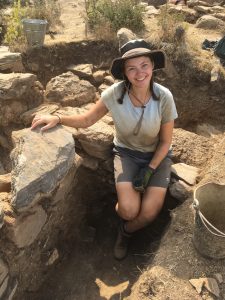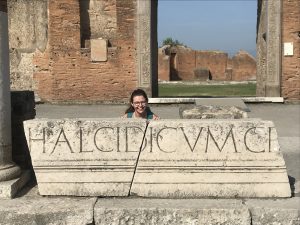
JuliAnne with a Byzantine wall in her unit.
Antiochia Ad Cragum Excavation, Gazipasa, Turkey, July 2018
This field experience provided the opportunity to learn the practical skills of archaeology through a hands-on approach. In the morning, we would excavate on site, and I quickly learned some of the basics such as the proper trowel technique and the difference between pottery and rock (and, yes, licking does help you distinguish them!). The afternoons were filled with pottery related activities, from washing to drawing, I gained a familiarity with the pottery discovered on our site. After dinner, my unit partner and I would record our notes in the official field journal. Through this process, I gained confidence in archaeological theory, and actually interpreting the material evidence uncovered at our site.

JuliAnne with a large Latin inscription in the Pompeii forum.
Ancient Graffiti Project, Pompeii, Italy, June 2019
My work with the Ancient Graffiti Project was a very different type of archaeology: non-destructive. As such, I was not even allowed to touch the plaster on which the graffiti had been inscribed. The goal of the Ancient Graffiti Project is to document ancient graffiti and make it available on the AGP website for scholars and students who are not able to study graffiti in the field. To accomplish this goal, we spent most of our time in the field measuring, drawing, and photographing graffiti. We also took thorough notes as to the condition and content of the graffiti. Through this field experience, I gained a whole new skill set with digital documentation and epigraphy (aka the study of inscriptions).
For more about the Ancient Graffiti Project, see their website here.